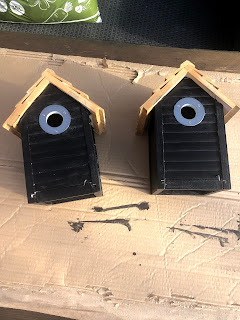Malta
Last month we visited Malta for a well-needed winter break, and as is tradition whilst away visited a couple of gardens.
University of Malta Argotti Botanical Gardens is situated just outside of the capital Valetta in the aptly named town of Floriana. It is hidden from view behind the enormous Church of St. Publius. Once there, a small donation gains you entry via a buzzer system where you are taken into a resource centre and provided with a receipt - the staff are so welcoming.
The garden used to be two gardens and has existing since the early part of the 18th century. Having had several iterations they were taken over by the University in 1805. The Department for Agriculture took brief ownership in 1973 (great year to be born), prior to the transfer back to the UoM in the mid-nineties.
The garden used to be two gardens and has existing since the early part of the 18th century. Having had several iterations they were taken over by the University in 1805. The Department for Agriculture took brief ownership in 1973 (great year to be born), prior to the transfer back to the UoM in the mid-nineties.
You can in fact walk around the circumference of the garden without entering but then you miss out on the vast cornucopia of plant species, the different levels and the interesting views of unusual plant-life against different architectural backdrops.
One such view is a climb up some precarious metal steps on the side of a building to the Herbarium roof garden covered almost entirely in potted cacti and complete with greenhouse also packed with cacti.
One such view is a climb up some precarious metal steps on the side of a building to the Herbarium roof garden covered almost entirely in potted cacti and complete with greenhouse also packed with cacti.
Other items that caught our attention were the indigenous Euphorbia dendroides, in the Mediterranean Plants garden, which here was over 6 foot in height and just as wide. Also, the bright green of the Asparagus densiflorus 'Myers' (Plume Asparagus) in a pot at our feet, the various Agave and the Schefflera (Umbrella Paint) happily thriving outside.
Reminders of home were provided with the very rare Silene fruticosa (Woody Catchfly) that has identical foliage to our Amorpha fruticosa - fruticosus relating to shrubby/bushy.
 |
 |
 |
 |
 |
 |
 |
 |
 |
Information placards within the garden describe the different themes and educational sections such as:
Japanese Garden - A place to meditate within the patterns and rhythms of the landscape
Indigenous Maltese Plants - Drimia maritima, Euphorbia dendroides, Olea europeae, Jacobaea maritima and Sedum sediforme
What's on a Plant Label - Accession number, Scientific name, Plant family, Orgins of species, Common names and Distribution
San Anton Gardens is located towards the centre of the island in Balzan, a short 18 euro taxi-ride from Valetta.
Here, under the canopy of many trees is a beautiful, peaceful and well presented walled space that surrounds the Presidential Palace.
As you enter the gardens along a pathway towards the main walled area, a plan of the gardens on a wall indicates its layout.
We were attracted towards the simple Melitensia Garden - 'Creating a Maltese Landscape' area, probably because of its stark contrast to gardens in the UK, the spectrum of green against the ochre stone an interesting and inviting sight.
Lush textures of Jacobaea maritima subspecies Sicula, Cistus creticus, and height provided by the Ceratonia siliqua (Carob Tree) caught our attention. The now familiar Euphorbia dendroides, here a massive cushion-like presence out in the open in full-sun as opposed to the tree-like form at Argotti against a wall in shade.
 |
 |
 |
 |
 |
 |
Familiar albeit absolutely enormous versions of trees such as Laurus nobillis (Bay Tree) provide shade, the height of the Strelitzia nicolai (White Birds of Paradise - South Africa) impressive despite having reached the end of the flowering season.
The unusual bark of the Chorisia speciosa (Silk Floss Tree - South America) caught my eye. The spines reminded me of the thorns on a rose that I have since learn't (thank you GQT), aren't thorns at all but 'prickles'.
The flowers dropping from the Casimiroa edulis (White Sapote - Central America) pretty star-like droplets.
With all this dry weather the drip-irrigation system in use across the large flower-borders was evident.
Having recently participated in a Coniferous ID test, my long-running dislike of these trees was tested to the max. Having spent a number of weeks learning their scientific names, I began to have positive feelings for some of them. Realising that the grand Pinus I had hugged at Arley Arboretum were one Genus in the conifer family, really opened my eyes to new possibilities. I have learn't that I should not be so quick to judge without first investing time gaining knowledge on the subject.
The large Orangerie here has a backdrop of various coniferous trees including Pinus Halepensis (Aleppo Pine - Med), Cupressus semprervirens (Mediterranean Cypress - Med) and Araucaria heterophylla (Norfolk Island Pine) which has vulnerable conservation status.
 |
 |
 |
 |
 |
 |
Other trees that emerged during our visit purely due to their difference were the Schinus terebinthifolius (Brazilian Pepper - S America), Synadenium grantii (African Milk Bush - Africa), Sapindus saponaria (Wingleaf Soapberry - North America) and Harpullia arborea (Tulip Wood Trea (SE Asia/Australia)
Particular elements of the garden hold your attention and add extra layers, the water areas and Italianate fountains, the sculpture, the diverse wildlife, the black swans and the peacocks roaming the grounds - both of these gardens are well worth paying a visit.



Comments